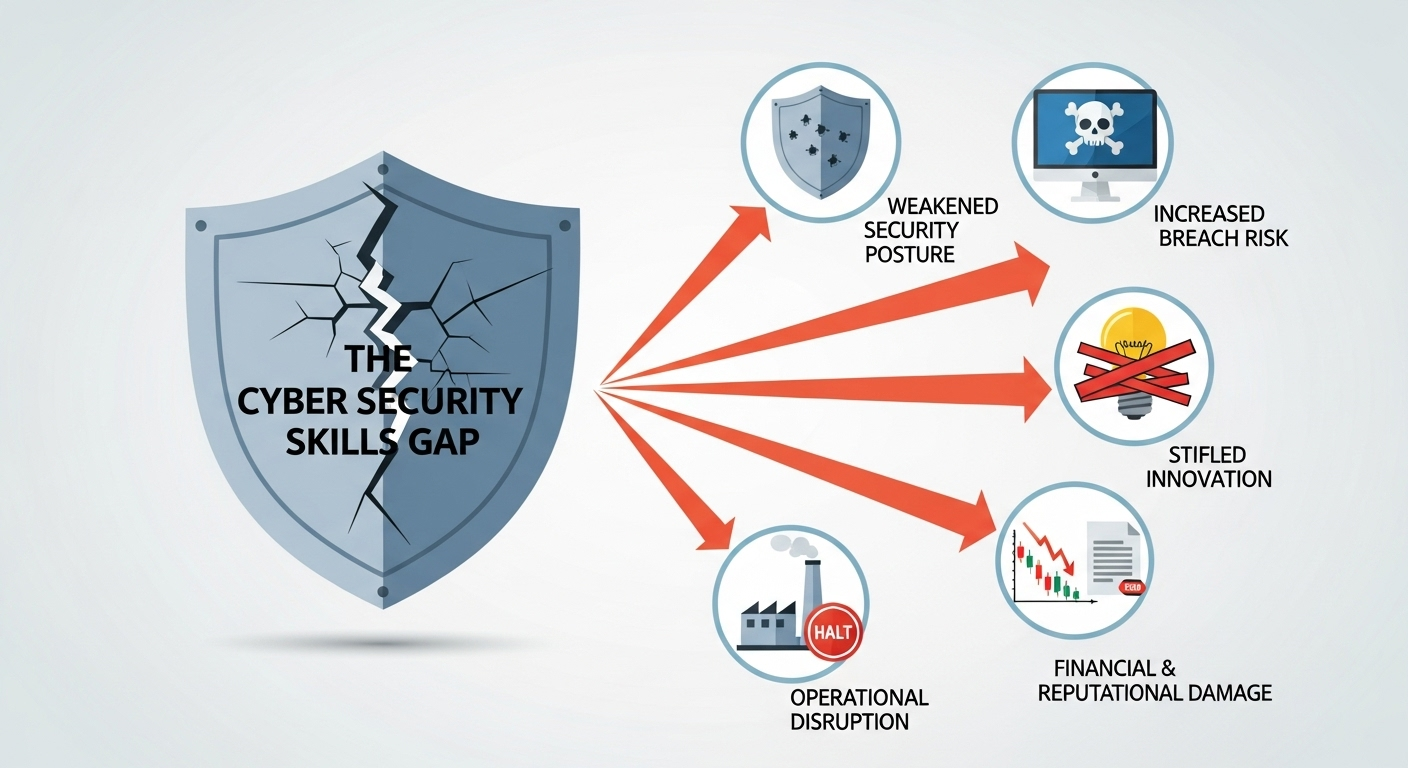The Cyber Security Skills Gap: Unpacking Business Impact & Future Risks


Introduction: The Looming Crisis You Can't Afford to Ignore
The cyber security skills gap, the chasm between the demand for qualified security professionals and the available talent pool has evolved from a nagging HR issue into a critical strategic vulnerability. With global cybercrime costs projected to hit an astonishing $10.5 trillion annually by 2025, the lack of skilled defenders is no longer a future problem. It's a clear and present danger to every organisation's bottom line, reputation, and long-term viability.
The Challenge of the Cyber Security Skills Gap
The core of the problem is a simple, yet severe, imbalance. The growth in digital infrastructure, cloud adoption, and interconnected devices has exponentially expanded the attack surface that organisations must defend. Simultaneously, the threat landscape has become more complex, with attackers leveraging automation and AI to launch faster, more sophisticated campaigns. This dual pressure has created an unprecedented demand for a cyber security workforce equipped with advanced skills, but the supply of such talent has failed to keep pace. This isn't merely about filling empty seats: it's about finding individuals with the right combination of technical expertise, analytical prowess, and experience to navigate a constantly shifting digital battlefield.
Why This Gap is a Strategic Business Imperative, Not Just a Hiring Problem

The skills gap creates a ripple effect of strategic risks, impacting an organisation's security, innovation, and financial stability.
Viewing the cyber security skills gap solely through the lens of recruitment is a critical mistake. Its impact permeates every level of an organisation. A shortage of skilled personnel directly weakens an organisation's security posture, leaving it exposed to breaches that can halt operations, erode customer trust, and trigger severe financial penalties. It stifles innovation, as new technology projects are delayed or shelved due to a lack of security oversight. Ultimately, an unaddressed skills gap becomes a strategic liability, hindering an organisation's ability to compete, adapt, and grow securely in a digital-first world. It is a board-level concern that requires a strategic, enterprise-wide response.
The Current State of the Cyber Security Skills Gap: A Quantified Reality
To grasp the severity of the challenge, it is essential to look beyond anecdotal evidence and examine the hard data. The numbers paint a stark picture of a global workforce struggling to meet overwhelming demand, creating significant vulnerabilities across all sectors.
Defining the Cyber Security Skills Gap: What the Numbers Reveal
The cyber security skills gap is not a theoretical concept; it is a measurable crisis. Recent analysis projects a staggering 4.8 million unfilled cybersecurity jobs globally in 2025, a testament to the immense disparity between supply and demand. This shortage is accelerating, with the World Economic Forum reporting that the cyber skills gap increased by 8% since 2024. This means that even as more individuals enter the field, the growth in demand continues to outpace the expansion of the talent pool. This persistent lack of qualified cyber security professionals leaves organisations dangerously under-resourced, forcing them to operate with overburdened teams and incomplete security controls. For instance, even in a mature market like the UK, where approximately 143,000 individuals are employed in cyber security roles, a significant shortage persists, highlighting the universal nature of the challenge.
Key Areas of Shortage: Where Expertise is Most Lacking
The skills shortage is not uniform; it is most acute in high-impact, specialised domains. Organisations are desperately seeking expertise in areas that are critical for modern defense:
- Incident Response (IR): The ability to quickly detect, contain, and remediate a security breach is paramount. A lack of experienced IR professionals means attacks can linger undetected for longer, causing significantly more damage.
- Cloud Security: As businesses migrate to complex multi-cloud environments, the demand for professionals who understand cloud architecture, configuration management, and platform-specific security tools (AWS, Azure, GCP) has skyrocketed. Misconfigurations in the cloud remain a primary vector for data breaches.
- AI/ML Security: The rise of artificial intelligence presents a dual challenge. Organisations need experts who can secure their own AI/ML systems from adversarial attacks and also leverage AI to enhance their defensive capabilities. This emerging field has a very limited talent pool.
- Application Security (AppSec): With software underpinning every business process, professionals who can integrate security into the development lifecycle ("DevSecOps") are in high demand to build more resilient applications from the ground up.
Unpacking the True Business Impact: Beyond the Obvious Financials
The consequences of the cyber security skills gap extend far beyond the IT department, inflicting deep and lasting damage on an organisation's financial health, operational stability, and market position.
Direct Financial Repercussions
The most tangible impact is the direct hit to the bottom line. Understaffed security teams lead to slower incident response, which directly correlates with higher breach costs. Organisations lacking adequate talent often suffer greater data loss and prolonged system downtime. This vulnerability is reflected in broader industry trends, with 87% of organisations experiencing at least one breach in the past year, many citing insufficient staff training as a key factor. Furthermore, the internal threat is magnified by a lack of oversight. Insider threats now cost organisations an average of $17.4M annually, a cost that is amplified when there aren't enough skilled eyes to monitor internal systems. This financial strain is compounded by soaring cyber insurance premiums, as underwriters penalise companies with demonstrable gaps in their security workforce.
Operational Disruptions and Business Continuity Risks
A successful cyberattack against an under-defended organisation can bring business operations to a grinding halt. Ransomware attacks, for example, can lock up critical systems for days or weeks, crippling supply chains, manufacturing processes, and customer service delivery. The lack of a robust incident response team means recovery is slow and chaotic. This operational paralysis is not limited to active attacks. The day-to-day work of security operations, patch management, vulnerability scanning, threat hunting becomes backlogged, creating a state of perpetual risk where a minor issue can quickly escalate into a major business disruption.
Reputational Damage and Erosion of Trust
In the digital economy, trust is a core asset. A significant data breach, especially one perceived as preventable, can shatter customer confidence overnight. News of compromised personal data or service unavailability spreads rapidly, leading to customer churn and long-term brand damage. Rebuilding a reputation is a slow and expensive process that requires far more than a technical fix. It involves transparent communication and a demonstrated commitment to improving security, a commitment made hollow if the organisation cannot attract and retain the necessary cyber security talent.
Strategic Disadvantage and Market Erosion
The cyber security skills gap also acts as a powerful brake on innovation and growth. New digital initiatives, such as launching an e-commerce platform, adopting IoT technology, or integrating AI, all introduce new security risks. Without sufficient cyber security expertise to assess and mitigate these risks, organisations are forced into a difficult choice: forge ahead and accept a higher level of vulnerability, or delay strategic projects, ceding ground to more agile competitors. This strategic paralysis can lead to a gradual erosion of market share and a failure to capitalise on new opportunities.
The Compounding Challenge: Future Risks Amplified by the Skills Gap
If left unaddressed, the current skills gap will not only persist but will also amplify future risks, creating systemic vulnerabilities that threaten economic and social stability.
Escalating Threat Landscape and Sophistication
Adversaries are not standing still. They are continuously innovating, using AI and automation to scale their attacks and develop new techniques. The rise of AI, in particular, is a game-changer. Datapatrol reports that 67% of security leaders state that AI has already expanded their organisation's attack surface. Without a cyber security workforce that is constantly upskilling to understand and counter these advanced threats, organisations will be fighting tomorrow's battles with yesterday's tools and knowledge, a recipe for certain failure.
Strategic Interventions: Bridging the Gap for Business Resilience and Future Security
Closing the cyber security skills gap requires a multi-faceted strategy that moves beyond traditional recruitment and focuses on building a sustainable talent pipeline and a culture of security.
Redefining Talent Acquisition and Pipeline Development
Organisations must broaden their search for talent. This means embracing skills-based hiring, where demonstrable competencies and practical experience are valued over traditional degrees or certifications. Companies can build their own talent pipelines through apprenticeships, internships, and partnerships with universities and coding bootcamps. Actively recruiting from diverse backgrounds including different genders, ethnicities, and neurotypes not only widens the talent pool but also brings new perspectives to problem-solving.
Retention and Upskilling of the Existing Workforce
It is often more effective to develop internal talent than to compete for it externally. Companies should invest heavily in continuous training and professional development for their existing IT and security teams. Creating clear career paths for cyber security professionals, offering competitive compensation, and fostering a supportive work environment are critical for retaining top talent and preventing burnout. Upskilling programs can help non-security staff develop "security champion" roles within their departments, embedding security awareness across the organisation.
Strategic Leadership and Cultural Shift
Addressing the skills gap must be a leadership priority. The board and C-suite must recognise cyber security as a core business function, not just an IT cost center. This involves fostering a security-first culture where every employee understands their role in protecting the organisation. When leadership champions security, it becomes easier to secure the budget for necessary training, tools, and talent.
Conclusion: A Call to Strategic Action for a Secure Future
The cyber security skills gap is one of the most pressing strategic challenges of our time. It is a complex issue fueled by rapid technological change and an evolving threat landscape, and its impact is felt across every sector of the global economy.
The Path Forward: Building a Resilient and Future-Ready Cyber Security Workforce
Closing the cyber security skills gap is a shared responsibility. It requires collaboration between industry, academia, and government to create clearer pathways into cyber security careers. For individual organisations, the path forward begins now. By redefining talent strategies, investing in their current workforce, and making security a cultural cornerstone, businesses can not only mitigate their own risk but also contribute to building a more resilient and secure digital future for everyone.
Here at Pentest People, we are always looking into expanding our team of consultants and other departments, have a look at our careers page here: https://www.pentestpeople.com/careers
.png)








.svg)








.webp)


